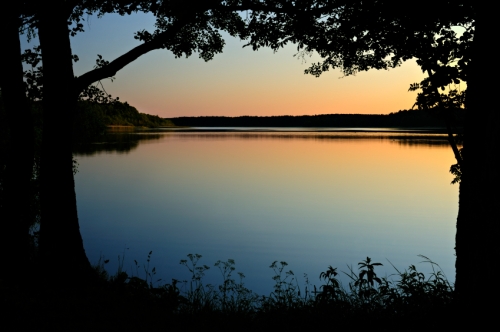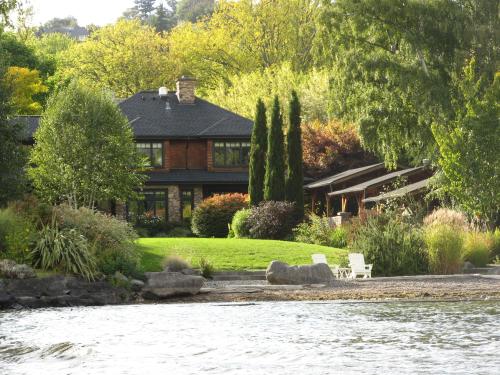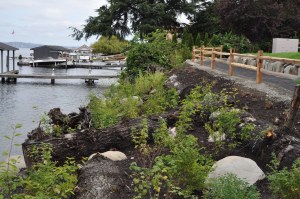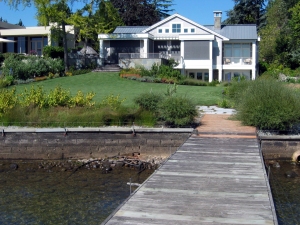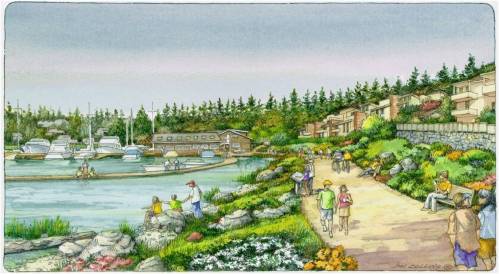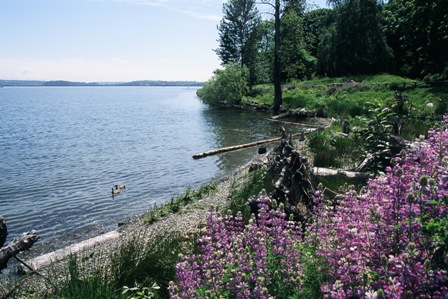Growing salmon need small creek deltas and small creek mouths for rearing, but after years of development, many historic creeks have vanished or been directed to drainage pipes. Docks and bulkheads along the lakeshore can also limit habitat. In 2014, the City of Seattle re-established 440 feet of natural stream channel through southeast Seattle’s Beer Sheva Park and reconnected the creek to Lake Washington to provide critical habitat for juvenile Chinook salmon. The newly-restored Mapes Creek is now one of a series of “rest stops” the City of Seattle is recreating for juvenile Chinook along the Lake Washington shoreline. By replacing the piped creek outlet with a daylighted connection to Lake Washington, the project will also reduce stormwater overflows, which can release untreated water to Lake Washington during heavy rains. Other improvements to the park, in one of Seattle’s most diverse and historically underserved neighborhoods, included adding native plants , walkways and artwork, and enhancing park drainage. Funding for the project – nearly $4 million — was provided by Seattle Public Utilities’ capital improvement program, Seattle Parks and Recreation, and the City of Seattle’s 1% For Art program. Grant funding was provided by the King Conservation District, Salmon Recovery Funding Board, and the Puget Sound Acquisition and Restoration program Learn more about this project at: http://www.seattle.gov/util/EnvironmentConservation/Projects/MapesCreek/index.htm
Posted in Uncategorized | Leave a Comment »
Juvenile Chinook like to hang out along shorelines close to river mouths, seeking shallow areas with overhanging plants where they can feed and grow while protected from predators. There’s not a lot of habitat like that left around our urban watershed. Thus a recent project restoring 1,300 feet of Lake Washington shoreline adjacent to Boeing’s Renton plant near the mouth of the Cedar River – where 150,000 cubic yards of fill was dumped in the lake 50 years ago — was key to preserving a critical corridor for migrating salmon.
Partnering with Boeing, the Washington State Department of Transportation (WSDOT), the U.S. Fish and Wildlife Service and Washington’s Department of Ecology, the Washington State Department of Natural Resources (DNR) completed this, the largest shoreline enhancement project in South Lake Washington, early in 2015. With $154,000 from the Salmon Recovery Funding Board (SRFB) to initiate the project and pay for design, the partnership provided roughly $3 million to finish the job.
Project crews worked to restore habitat by:
- Removing from the shoreline 900 feet of a derelict flume wall, bulkheads, 21 creosote pilings, riprap and other debris.
- Placing sand, gravel and cobbles to improve habitat, expanding the existing sandy cove, which three years of pre-project monitoring showed was favored by juvenile Chinook.
- Installing three groups of logs to further improve this shallow-water habitat.
- Relocating Boeing’s stormwater outfalls (at the company’s expense) to deeper water to keep runoff away from shoreline habitat.
- Removing blackberries and other invasive plants from three upland acres, and replanting with willows and other natives.
WSDOT, involved in part as mitigation for the construction of the new SR-520 bridge, will monitor the site for ten years.
DNR project staff Monica Shoemaker notes that nearby Bird Island, part of Gene Coulon Park but on state property, would be a great next project in the ongoing process to improve Lake Washington shorelines for salmon.
Learn more about this project here: http://www.dnr.wa.gov/Publications/em_fs12_005.pdf
Posted in Uncategorized | Leave a Comment »
Two new tools will help you navigate the permit process for your green shoreline, dock or other shoreline project. The Governor’s Office of Regulatory Assistance (ORA) web site now contains an updated project questionnaire and new examples of shoreline permits.
Project questionnaire
You start the online questionnaire by answering basic questions about your project.
The questionnaire will first ask you to choose a city or county. The next page gives you an option of checking the box for a “Green Shorelines” project. Other common shoreline project types include “Watercraft Lifts” and “Docks and Piers.”
Dividing the questionnaire into project types allowed ORA to simplify and reduce the number of questions, asking only questions specific to the project.
Green Shorelines questionnaire
The system will ask you to answer 11 questions, such as “Will you be repairing or modifying a bulkhead?” and “Will you be creating a new beach cove?” Each question includes a tip, such as “Check with your local jurisdiction. Your project may qualify for Shoreline Exemption.” Continue Reading »
Posted in Shoreline development, Uncategorized | Tagged Governor's Office of Regulatory Assistance, shoreline permit | Leave a Comment »
Terri Olson Miller set back the bulkhead at her Lake Washington home because she wanted a beach. Her family loves it–and so do young salmon.
Find out more here.
Posted in Demonstration sites, Shoreline homeowner, Videos | Tagged beach, Lake Washington, Terri Olson Miller | Leave a Comment »
Joanna Buehler has transformed her property on Lake Sammamish from just a bare lawn to an attractive, diverse landscape. Native vegetation attracts birds and wildlife and protects her shoreline against erosion.
Find out more at the Green Shorelines website.
Posted in Demonstration sites, Shoreline homeowner, Videos | Tagged buffer, fish and wildlife, Joanna Buehler, Lake Sammamish | Leave a Comment »
 Wolf Bauer is 100 years old. His ideas about shorelines have shaped an entire generation.
Wolf Bauer is 100 years old. His ideas about shorelines have shaped an entire generation.
Now Hugh Shipman, a coastal geologist with the Department of Ecology, has compiled one of Bauer’s remarkable slide shows into a book: Wolf Bauer’s Inland Sea: Wolf Bauer’s Presentation of the History, the Processes, and the Management of Beaches in Washington and British Columbia.
“I owe much of my excitement about beaches to Wolf,” Shipman said. “He made a huge difference by getting people to know and care about beaches. This book is a way to share his ideas with a wider audience.” Continue Reading »
Posted in Shoreline development, Wolf Bauer | Tagged beach, bulkhead, Erosion control, Hugh Shipman, Mountaineers, shoreline, Shoreline Management Act, Wolf Bauer | 1 Comment »
Earlier this spring, scientists saw herring spawning along the Seattle shoreline, between Pier 70 and the grain elevator. The Washington Department of Fish and Wildlife (WDFW) called it an “unusual and exciting event.” This is the first time they have ever seen spawning herring in this urban area. Continue Reading »
Posted in Herring spawning, Parks | Tagged City of Seattle, Herring, Myrtle Edwards Park, Olympic Sculpture Park, spawning, Washington Department of Fish and Wildlife | 4 Comments »
What do young salmon need along the shoreline to help them survive? What do they find? Roger Tabor has answers to these questions. Roger has researched salmon in Lake Washington for the US Fish and Wildlife Service for 20 years.
Find out more at the Green Shorelines website.
Posted in Salmon research, Shoreline development, Videos | Tagged bulkhead, fisheries science, juvenile salmon, Roger Tabor, salmon research, US Fish and Wildlife Service | 1 Comment »
“Sure, I like plants, but maintaining my view of the water is a higher priority.”
Many homeowners favor large expanses of lawn because they see it as the best way to protect their view. The truth is that diverse plantings can accent and improve views.
Framing views is an important principle of garden and landscape design.
- Identify which views you want to keep and enhance.
- Identify which views would be better screened. For example, perhaps you’d rather not look at your neighbor’s shed or boat house. Continue Reading »
Posted in Frequently asked questions, Trees, View | Tagged framing views, Tree, Tree pruning | Leave a Comment »
Just ask the goose. Sebastian the Talking Goose says geese prefer your lovely manicured lawn over a beach and natural plantings. Taking out part of your lawn to add a beach will likely mean fewer geese stop in to graze. Continue Reading »
Posted in Canada geese, Frequently asked questions | Tagged Geese, Lawn, Sebastian the talking goose | 1 Comment »
Some homeowners are reluctant to add a beach because they are concerned about losing property. While it is true that green shorelines sometimes result in smaller lawns, the square footage remains the same. Some of the lawn is replaced with a beach and shoreline vegetation.
Essentially, you’re converting your property from one use to another. A good design will maintain the ordinary high water mark line so there is no loss of dry land. Continue Reading »
Posted in Frequently asked questions, Shoreline homeowner | Tagged beach, ordinary high water, Seattle | Leave a Comment »
The City of Kirkland’s new Shoreline Master Program update contains an innovative tool: a “decision tree” for shoreline property owners.
A homeowner can determine options to stabilize the shoreline based on:
- The home’s setback from the water
- Bulkhead height
- Depth of water at bulkhead
- Nearshore slope
- Yard slope
Options could include a full beach, beach cove, pulling back or modifying the bulkhead, slope bioengineering and adding gravel to the nearshore. Continue Reading »
Posted in Shoreline development, Shoreline Master Program | Tagged City of Kirkland, decision tree, shoreline stabilization | Leave a Comment »
People who are interested in a green shoreline often want to see examples. “What will it look like? Will it protect my property? Show me.”
Several parks around Lake Washington have restored their shorelines. These demonstration projects are open to the public. Seeing these sites can help answer questions, although the project scale and its goals may differ from a shoreline home. Continue Reading »
Posted in Demonstration sites, Parks | Tagged Chinook Beach, Denny Blaine Park, Lid Park West, Luther Burbank Park, Madrona Park, Map, Martha Washington Park, Seward Park | 3 Comments »
The City of Bellevue has created a plan to expand and restore Meydenbauer Beach Park and to connect the Lake Washington waterfront with downtown Bellevue. Enhancements to the park and nearby streetscape improvements will create a pleasant place to walk, socialize and enjoy the water. The project will restore 800 feet of shoreline along Meydenbauer Bay, improving salmon habitat.
Posted in Demonstration sites, Landscape architecture, Parks | Tagged City of Bellevue, Meydenbauer Beach Park | 1 Comment »
The Friends of Madrona Woods restored Madrona Creek from an underground pipe to a small stream leading to a new wetland cove along Lake Washington. They also transformed 10+ acres of natural area in Madrona Park from a neglected, dark, scary and weed-infested forest into an open, inviting and healthy native forest with trails, waterfalls and natural creek channels flowing to Lake Washington. Studies have found that juvenile Chinook salmon congregate near small creek mouths along the shoreline, so the project will provide valuable rearing and refuge habitat for young salmon. Map to Site.
“Somehow, by taking one season and one task at a time, a few people have transformed a derelict greenspace that invited dumping and nefarious activities into an urban forest that is beautiful, safe and inviting,” said Deirdre McCrary, Friends of Madrona Woods board member. Continue Reading »
Posted in Demonstration sites, Landscape architecture, Parks | Tagged community groups, Friends of Madrona Woods, Madrona Woods, Seattle | 3 Comments »
